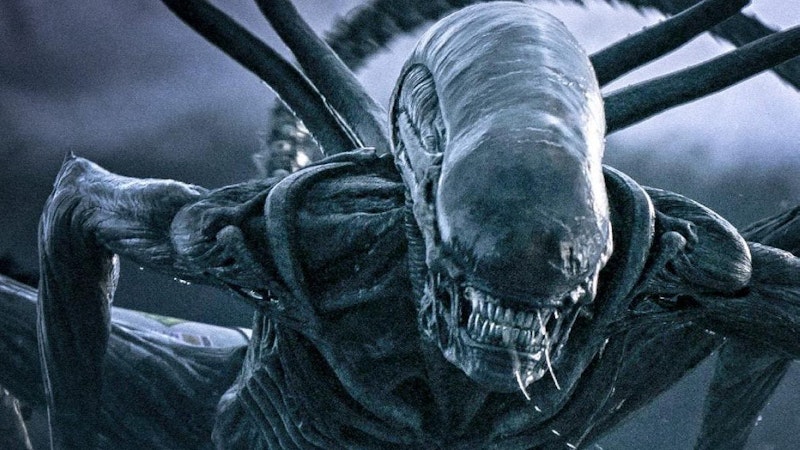The Alien franchise has churned out new installments for nearly five decades, and it's largely due to the saga’s aptitude for ingenuity. While this doesn’t mean that every installment in the series has the same legacy as Ridley Scott’s 1979 masterpiece, the Alien films have rejected nostalgia in favor of subversive directions. If Scott’s original was a confined thriller pitched as “Jaws in space,” James Cameron’s 1986 sequel Aliens was an action blockbuster that rivaled Raiders of the Lost Ark and The Empire Strikes Back. Even David Fincher’s Alien 3, derided at the time as too mean-spirited, was a confined prison drama that thematically linked the Xenomorph creatures to the ongoing AIDS crisis.
The refusal to retain a status quo may be the reason why the Alien series never reached the box-office heights of franchises like Star Wars or Jurassic Park. Beyond the fact that they’re R-Rated films, the Alien films have placed so much faith in the individual auteurs responsible for them that they’ve often veered out of control. 1997’s Alien: Resurrection plummeted to the original franchise when French filmmaker Jean-Pierre Jeunet applied his expressionist sensibilities to a fairly dull space opera, and the Alien vs. Predator spinoff series did nothing to convince audiences that the franchise wasn’t washed. While Scott returned for the prequels Prometheus and Alien: Covenant, less generous audiences were distintered in the philosophical undertones that unpacked the relationship between man and his creator.
Studios have increasingly proven they owe no loyalty to their franchise auteurs, as the intellectual properties are more valuable than the artists that initially created them. An underperformance for Alien: Romulus, which fell in the midst of Walt Disney Pictures’ acquisition of 20th Century Fox, meant that Scott’s plans for a new prequel were dropped in favor of a younger filmmaker more willing to “give the fans what they want.” Fede Alvarez, the mind behind the gruesome reboot of Evil Dead and the Don’t Breathe slasher franchise, made a new Alien film that would supposedly bring the franchise “back to basics.”
Alien: Romulus isn’t the worst entry in the Alien franchise, but it’s the most compromised. Set during a largely unexplored period with the franchise timeline between the events of the first two films, Alien: Romulus is centered around a group of space colonists whose voyage to an enigmatic space station is hijacked by a ruthless Xenomorph. The familiarity of the premise extends to the protagonists; Cailee Spaney’s performance as the orphaned miner Rain Carradine is evocative of Sigourney Weaver’s Ellen Ripley, and the kind-hearted android Andy (played by Industry breakout star David Jonsson in an impressive performance) is intended to fill the void left by Lance Henriksen’s Bishop in Aliens.
Alien: Romulus rarely fails to entertain due to the expert craftsmanship on display. Alvarez is an inventive visual storyteller, and it’s inspiring that he built a vast, dense vision of 2142 on a reported budget of $80 million. Unfortunately, any good will that Alien: Romulus may have earned is evaporated by a critical moment in the third act in which Rain, Andy, and the rest of their crew stumble upon the android Ash, who was played by Ian Holm in the 1979 film. Holm passed away in 2020, but computer-generated imagery was utilized to replicate his likeness, with the A.I. software speecher used to create new dialogue from his voice.
The use of CGI to “de-age” an older actor is a recurring trend in blockbuster cinema; Samuel L. Jackson lost nearly 30 years to appear as a younger version of his Marvel character Nick Fury in Captain Marvel, and Michael Douglas did the same for segments of Ant-Man. As off-putting as it is to see a digitally crafted 45-year-old Harrison Ford in a fistfight with Nazis in the opening sequence of Indiana Jones and the Dial of Destiny, it’s far more unnerving if the CGI character is based off a dead actor. Although Alvarez claimed that a recut of the film released on streaming “fixed” some of the uncanny issues, it doesn’t make the idea any less ethically gross.
It’s not the first instance of a departed actor’s likeness utilized for a franchise property, as the late Peter Cushing was seemingly “revitalized” to appear as Grand Moff Tarkin for a key sequence in 2016’s Rogue One: A Star Wars Story. Although the choice is just as perplexing, the argument Lucasfilm put forward was that it was necessary to use Cushing’s version of the character due to his relevance to the story, which involved the creation of the Death Star weapon. Cushing had to appear in order to retain continuity with Star Wars: Episode IV- A New Hope, in which he appeared in 1977. It was a creative excuse, but not one that applied to Alien: Romulus; Ash serves no critical purpose in the film.
This may seem minor, but given how radically Hollywood has become reliant on A.I., it’s not to be taken lightly. An insistence on the retention of continuity would scrub many classic performances from existence; had The Godfather: Part II been made today, it likely would’ve featured a digitally de-aged Marlon Brando as a young Vito Corleone, and not Robert De Niro. Alien: Romulus is a bland summer blockbuster that’s unlikely to be remembered by the time that its sequel comes around, but it may have set a dangerous trend that could reshape the casting process as it’s known.

